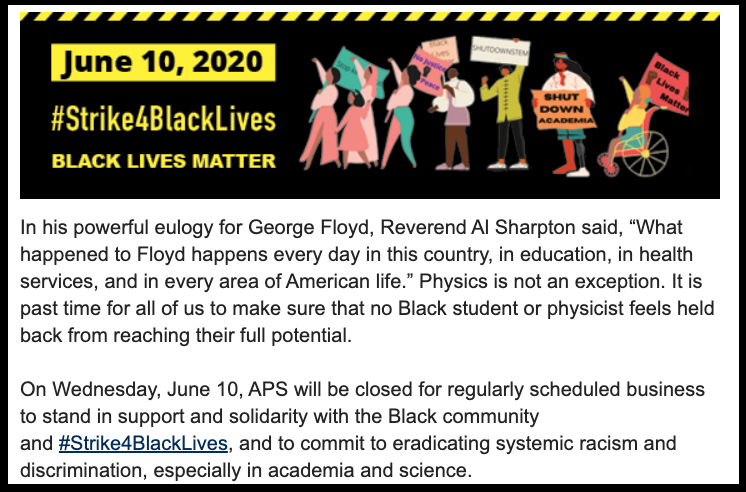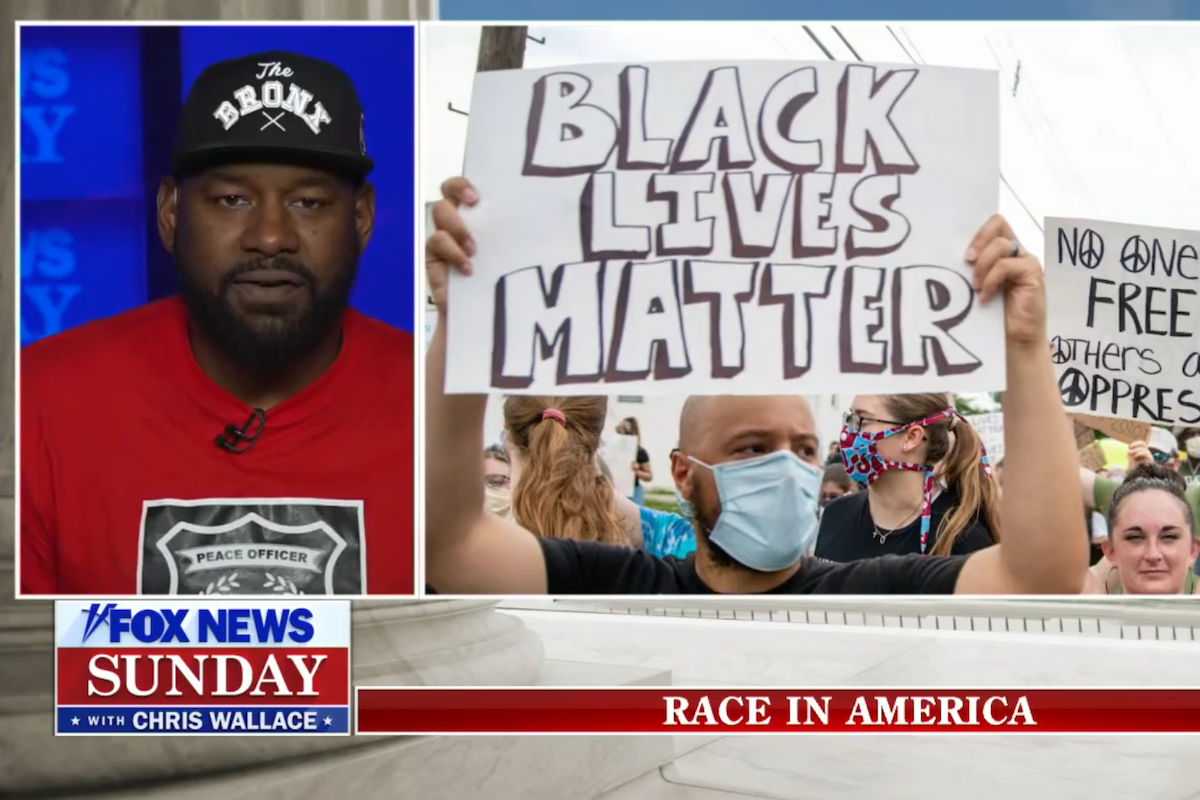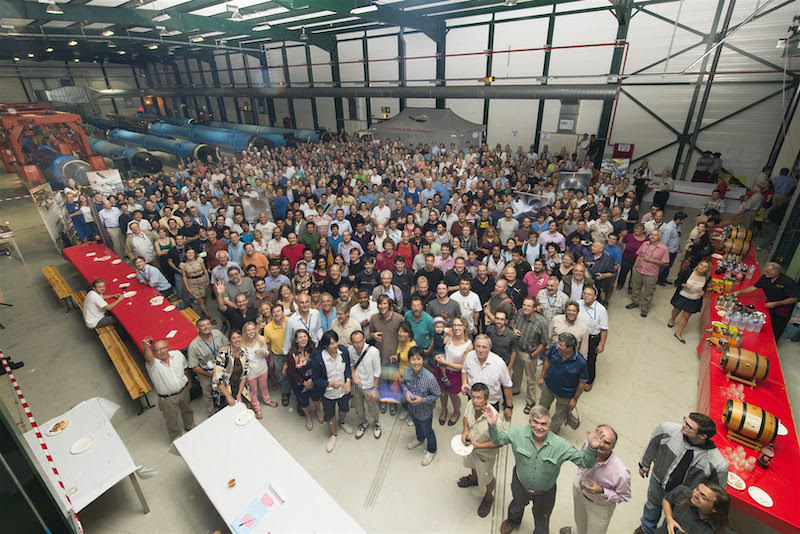Diversity Debate
Racism Is Real. But Science Isn’t the Problem
There are fewer tenured black physicists at universities and laboratories because there are fewer black PhD physicists.

In his June 9th eulogy for George Floyd, Reverend Al Sharpton said, “What happened to Floyd happens every day in this country, in education, in health services, and in every area of American life.” The metaphor goes to the suffocation of hopes, dreams, and basic rights among many black Americans, in part because of inequities in American society, and in part because of direct experiences with racism.
Several days later, the American Physical Society (APS), which claims to represent 55,000 physicists working in the United States and abroad, quoted Sharpton’s statement in announcing its solidarity with the “#strike4blacklives” campaign. The group declared that “physics is not an exception” to the suffocating climate of racism that Sharpton described; and that the APS would be closed for regularly scheduled business on June 10th, so as “to stand in support and solidarity with the Black community and to commit to eradicating systemic racism and discrimination, especially in academia, and science.” And the APS wasn’t alone. The strike was embraced by many scientific groups, national laboratories and universities. Throughout scientific disciplines, combating systemic racism has become a rallying cry.

It sounds laudable. But as argued below, mantras about systemic racism are hard to square with the principles and necessary protocols of academic science. And in any case, overhauling university hiring and promotion aren’t the way to address the fundamental underlying causes of racism in our society. The APS and other scientific organizations have adopted dramatic anti-racist posturing in sudden response to George Floyd’s homicide and the protests that followed. But in so doing, they risk unwittingly demeaning science and scientists, as well as trivializing the broader and more vicious impacts of real racism in our society.
Science is furthered by the development of theories that better explain nature, that make correct predictions about the world, and that may help develop new technologies. A scientific theory that can be supported by rigorous empirical observation, theoretical analysis, and experimental results; and which withstands scrutiny and critique from peers; will be adopted by the scientific community, independent of such theories’ origins. If the system is functioning properly, the people who develop these ideas and experiments rise in prominence. The nature of the scientific process requires it to be color-blind, gender-blind, and religion-blind.

This means that science can unite humanity in a way that’s unmatched by any other intellectual endeavor—for it transcends cultures, languages, and geography. Physicists in China and the United States may have vastly different political views and experiences. But at a physics conference, they interact as colleagues. The thousands of physicists who work at the Large Hadron Collider near Geneva, where I’ve worked in the past, hail from perhaps as many as 100 countries, speaking dozens of languages, and embrace vastly different faiths and political persuasions. Yet they’ve worked together to build the most complex machines ever devised, behemoths whose millions of separate parts function flawlessly on scales down to less than a millionth of an inch.

The claim that science per se is not racist is not the claim that no scientists are racist; nor that physicists of color never experience racism inside or outside of academia. My own PhD supervisor, who happened to be black, advised me that if I rented an apartment in the Boston neighborhood of Bunker Hill (as I considered doing for a short time), he wouldn’t feel safe visiting me. But such personal experiences, awful as they are, don’t primarily explain the under-representation of minorities in academic departments. The more fundamental problem isn’t the culture of science, but rather that many people of color get driven away long before they might experience this culture in the first place.
Between 1993 and 2005, I was chair of a university physics department in Cleveland, Ohio. The dismal situation in many inner-city Cleveland public schools struck me as a disgrace. At one point, when we renovated our building, I got permission to send some of our older elementary physics equipment to a nearby local, primarily black, public high school. In spite of the special nature of the school, which was for gifted students, it didn’t even have enough science textbooks to go around.
When I went to talk to students at a local inner-city school where my ex-wife volunteered, the children asked me what a scientist did. They didn’t have the slightest idea of what trajectory they could take to become one themselves, or whether it involved education beyond high school. The topic seemed so alien as to be beyond any of their realistic aspirations. Situations such as this remain common in many areas of the United States. And as long as they persist, there is little likelihood that the demographics of PhD scientists will reflect the underlying population.
During the academic strike called for by the APS, it was emphasized that the proportion of black physicists in national laboratories such as the Fermi National Laboratory in Illinois (where one #strike4blacklives organizer works) is much smaller than the percentage of blacks in the population at large. It was implied that systematic racism in the profession was responsible for this, although no explicit data supporting this claim was presented.
In fact, there is a simpler explanation. There are fewer tenured black physicists at universities and laboratories because there are fewer black PhD physicists. There are fewer black PhD physicists because there are fewer black physics graduate students. There are fewer black graduate students because there are fewer black undergraduates who major in physics. This latter fact is a cause for concern. But the root cause lies in inequities that arise far earlier in the education process. These cannot be addressed by affirmative action policies at the upper levels of practicing professional scientists.

In the early and middle decades of the 20th century, explicit forms of anti-Semitism were ingrained in the culture of many American physics departments. None other than legendary theoretical physicist Richard Feynman narrowly avoided rejection by Princeton because his background was Jewish. The head of the Princeton Physics Dept, H. D. Smyth, wrote to a colleague who’d recommended Feynman for graduate school: “One question always arises, particularly with men interested in theoretical physics. Is Feynman Jewish? We have no definite rule against Jews, but have to keep their proportion in our department reasonably small because of the difficulty of placing them [professionally].” (His colleague signaled assent, but added that Feynman’s “physiognomy and manner, however, show no trace of this characteristic and I do not believe the matter will be any great handicap.”)
How was this endemic anti-Semitism overcome? Thanks to the opportunities afforded by high-quality public education, students such as Feynman were able to shine in university. In spite of his background, he was accepted to Princeton’s graduate school, and went on to win a Nobel Prize and become one of the greatest physicists of his generation. This paved the way for another generation of Jewish theoretical physicists, including Sheldon Glashow and Steve Weinberg. As these future Nobelists rose to the top of their profession, anti-Semitism in academic hiring and promotion disappeared.
When I attended the Nobel Prize ceremony in 2004, there was only one female Nobelist on stage. The head of the Nobel committee candidly explained that there was a reason for this: Nobel Prizes usually are given for work done decades ago. And until relatively recently, there were far fewer women working in the science fields.
He indicated his hope that decades in the future, as more women thrive in these professions, their representation on stage at Nobel Prize ceremonies would increase. But he also emphasized that quality, not diversity, would remain the chief factor governing the awarding of prizes, and that diversity would follow organically as the participation of women in each field grew.
Such an approach counsels patience. Unfortunately, the rush to respond to George Floyd’s murder by wholesale condemnation of existing disciplines instead serves to encourage new forms of campus bureaucracy. The University of California, Berkeley, which already may have more diversity and equity assurance officers than almost any other public university, for instance, responded to recent protests by announcing the creation of yet another senior administrative post: Executive Director of Civil Rights and Whistleblower Compliance.
Accompanying this movement is the imposition of new demands on junior faculty that can impede their ability to do science, and sometimes serve to prevent departments from hiring the most productive young scientists. Many hiring committees and granting agencies demand equity and diversity statements from young scientists seeking faculty positions. Examples have been published of highly productive scientists whose grants have been rejected not on the basis of science, but because their diversity proposals were insufficiently detailed. “Could Albert Einstein get a job today at the University of California–Berkeley?” asked one Forbes columnist recently. “Or Enrico Fermi, or Robert Oppenheimer, or John von Neumann? With the University of California’s (UC) experiments in diversity screening underway, the answer is that their job applications could stall before a faculty hiring committee reviewed their academic qualifications.”
Assistant professors of physics cannot solve racial inequality in our society. The professional responsibility of individual scientists, especially young scientists, is to do the best science they can, and to train their students as best they can. It is not to become part of a social movement, however well-intentioned that movement may be.
As unfashionable as classically liberal ideas have become, I believe that good science is what should govern grant-proposal assessment and faculty hiring, with equal treatment for all, and quality alone being the final discriminator. Yes, the scientific community is part of the broader social fabric, and does not constitute a silo unto itself—which is why, in a democratic society, scientific results should be communicated broadly outside of academia. But this principle should not require that all scientists, especially young scientists, take time out from their research to actively engage in outreach programs designed to further social goals. These programs can be useful, and deserve to be encouraged among those with an appropriate interest and aptitude. But they are not to be confused with a scientist’s core work.
Part of the current problem arises from a misplaced notion that has become prevalent in the public dialogue about racism. It has been most clearly espoused by historian and National Book Award winner Ibram X. Kendi, who has argued that one is either racist, or anti-racist. Simply being “non-racist” is unacceptable. While Kendi may be a compelling writer, this claim presents a false dichotomy. One might wish to require that anti-racist policies be adopted in law, while at the same time adopting a race-neutral posture in professional contexts. Indeed, I believe that such an approach is central to the work of a scientist.
As my own experience shows, steps taken by academic bureaucrats to actively signal a posture of anti-racism often can be facile or counterproductive. I was chairman of a physics department for 12 years and witnessed several examples in this vein. In one case, our department had an opportunity to recruit an exceptional senior black physicist who was the spouse of a faculty candidate being recruited by another department. Yet my appeals to the diversity gurus at the university fell on deaf ears, because the potential recruit was born in Tobago. For purely geographical reasons, he wasn’t on the list of suitably underrepresented minorities. In other words, he wasn’t the “right kind” of black physicist.
As is now widely reported, the response of academic and scientific administrators to demands to root out systemic racism in academic science have created an academic environment where free speech and open inquiry—the hallmarks of good scholarship—are being threatened. Recently, a distinguished chemist at a Canadian university was publicly censured by his provost for an article he’d published in a distinguished journal, concerning factors impinging on the success of organic synthesis as a field of research and education. His crime was having an opinion about merit-based science and the impact of affirmative action policies on university hiring and research procedures. He stated that “each candidate should have an equal opportunity to secure a position, regardless of personal identification/categorization. Hiring practices that aim at equality of outcome [are] counterproductive if it results in discrimination against the most meritorious candidates.”
In normal times, such a statement might at most provoke vigorous debate. The same goes for his questioning of “the emergence of mandatory ‘training workshops’ on gender equity, inclusion, diversity, and discrimination.” Yet given the current climate, it was not surprising that this professor was instead censured by his university provost; and the editor of the journal in question removed the paper from its website, apologized for having published it, and suspended two of the journal’s other editors. The publication of a special issue of a chemistry journal being published in honor of the author’s 70th birthday was cancelled and mention of his body of work was eliminated from another journal.
Last week, the senior VP of research at Michigan State University, a physicist named Stephen Hsu, was removed from his position—despite numerous academics from around the country signaling support for him in an open letter—after a Twitter campaign falsely smeared him as a “vocal racist and eugenicist.” His crimes? First, his research involved using computational genomics to study issues that included how human genetics might be linked to cognitive ability. Second, as VP for research, he had supported the peer-reviewed research of an MSU psychology professor who’d studied police shootings, and whose data, analyzed by accepted methodologies, supported the idea that there is less statistical evidence for racial bias than is often reported.
Learning and scholarship require an environment in which hard questions can and should be asked, and in which informed research and debate lead us to better understandings of the world around us. If our efforts to combat the underlying racism in society end up marginalizing those who raise sensitive issues and prioritize knowledge over hashtags, the entire basis of higher education will be undermined. Whether such a tradeoff is worth it is, at the very least, debatable. But it seems that this kind of debate is no longer allowed.
I freely acknowledge that science as a discipline has its roots in a societal history rife with racism, sexism, and religious intolerance. But the same is true for the entire intellectual fabric of modern Western society. Will we need to destroy the pyramids because they were built by slaves, or remove the statues of Isaac Newton from physics buildings because of his religious intolerance?

This is where the current movement leads. If the label of systemic racism is universally applied across academic disciplines while we tear down everything that is connected through time to the darkest periods of history, then the legacy of the Scientific Revolution itself risks being lost amid the rubble.






